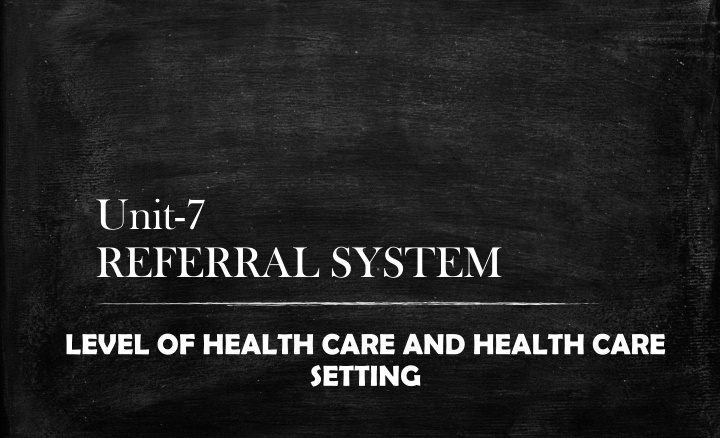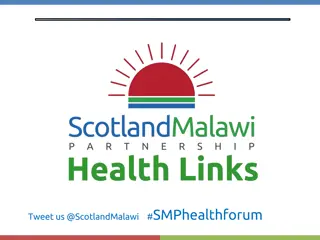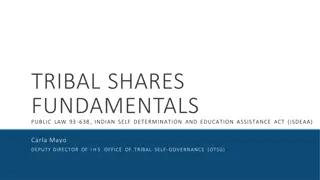
Referral System and Levels of Health Care
"Discover the primary, secondary, and tertiary levels of health care in the referral system, each playing a crucial role in promoting, maintaining, and restoring health at different intensities."
Download Presentation

Please find below an Image/Link to download the presentation.
The content on the website is provided AS IS for your information and personal use only. It may not be sold, licensed, or shared on other websites without obtaining consent from the author. If you encounter any issues during the download, it is possible that the publisher has removed the file from their server.
You are allowed to download the files provided on this website for personal or commercial use, subject to the condition that they are used lawfully. All files are the property of their respective owners.
The content on the website is provided AS IS for your information and personal use only. It may not be sold, licensed, or shared on other websites without obtaining consent from the author.
E N D
Presentation Transcript
Unit-7 REFERRAL SYSTEM LEVEL OF HEALTH CARE AND HEALTH CARE SETTING
INTRODUCTION Health care is a multitude of services rendered to individual, family or communities by the agent of health services or profession for the purposes of promoting, maintaining monitoring or restoring health. The health care goal of system is health development i.e. a process of continuous and progress improvement of health status of a population.
To achieve this goal health care services are usually organized at three level, each level supported by a higher level to which the client is referred. This levels are:
LEVELS OF HEALTH CARE Primary prevention Secondary prevention Tertiary prevention
PRIMARY HEALTH CARE also called as essential health care or health care at door step. It is the first level of conduct of individual, the family and community with national health. A level of health care, it is close to the people, where most of the health problem can be dealt with and resolved.
it provided at village level and through primary health centers and their sub-centers through the agency of multi-purposes health worker, village health guide, ASHA workers and trained dais. The measures of health promotion and prevention are taken a maximum effort at this level of health care. Bedsides providing primary health care the village healthteam .
SECONDARY HEALTH CARE the next higher level of care is the secondary (intermediate) health care level. At this level more complex problem are deal with. Care is generally provided in district hospital and community centers which also serves as the first referral level.
TERTIARY LEVEL The tertiary level is a more, specialized specific facilities and attention of highly specialized health workers. This care is provide by the regional or central level institutions. E.g. medical college hospital. All indian institutes, regional hospitals, specialized hospital and other apex institutions.
HEALTH CARE SETTINGS To meet the global commitment of HFA the health care setting are restructured through primary health care approach to provide universal comprehensive health care to the people which they can accept and afford.
Health care setting classified are A. Public system B. Private sector C. Voluntary health agencies. D. National health programme E. Indigenous system of medicine
PUBLIC SYSTEM Public sector is a government sponsored system. It is financed by public funds generated through taxes. Services are provided to rural and urban area through block level, district level, state level. BLOCK LEVEL-: Organizational structure at block level is developed under: 1. village level 2. SC 3. PHC 4. CHC
1. VILLAGE LEVEL Village health guide Traditional birth attendants(TBA) Aganwadi worker ASHA
2. SUB CENTER FUNCTION-: 1. field visit 2. MCH care and family women and children under 1 year 3. Training and supervision of dais. 4. IUD Insertion 5. Simple lab investigation
7. Health education 8. Birth and death registration 9. Record maintenance 10. health services
3. Primary health Center (PHC) PHC is first contact between the village community . It is the 1st structural and functional unit of public health services for rendering primary health services and health care peripheral area. PHC are established and maintained by the state govt. under the minimum need program. A PHC acts as a referral unit for SC and cover a population of 30,000 in plain area and 20,000 in hilly, area.
RECOMMENTED STAFFING PATTERN OF PHC Medical officer =1 Nurses midwife =1 Pharmacist =1 Health worker =1 Block extension educator =1 Health assistant female =1 Health assistant male =1 Lab technician =1 Drivers = 1 Class IV Employee =4 UDC & LDC =2 TOTAL STAFF= 15
4. COMMUNITY HEALTH CENTER The community health center constitute the secondary level of health care, were designed to provide referral as well as specialist health care to the rural population. Community health center are maintained by the state government under minimum need programe. Each CHC has 30 sectioned bed. It covers population 120,000 in plain and 80,000 in tribal ad backward area.
SPECIALIST SERVICES PROVIDED AT CHC Surgery Medicine Obstetrics and gynecology Pediatrics Dental and ENT
FUNTION OF CHC Routine and emergency surgery Routine and emergency medical care 24 hours delivery services including surgical intervention like CS. Essential and emergency obstetric care Newborn care Routine and emergency care sick children
RECOMMENTED STAFFING PATTERN OF CHC Medical officer- 04 Nurses & Mid wife (staff nurse)- 07 Dresser -01 Pharmacist/compounder-01 Laboratory technician-01 Radiographer-01 Ward boys-02
Dhobi-01 Sweepers-03 Mali -01 Chowkidar-01 Aya -01 Peon -01 Total staff = 25
B. Public system In private sectors ,there are specialty hospitals, super specialist hospitals, medical college hospitals and health clinics. Mission/ religious hospital; this type of hospital are charitable and run by trust or mission. They provide medical services FOC free of cost or minimum rate.
C. VOLUNTARY HEALTH AGENCIES These agencies are non-government and non-profit making. They are initiated, established and administered by private citizens. The members of the agencies hold meeting, collect funds for its functioning from private sources. FUNCTION-: Government can not provide complete health services because of financial restriction.
D. NATIONAL HEALTH PROGRAMS These problems include communicable and non communicable diseases, environmental sanitation, nutrition problem and population problem etc
E. INDIGENOYS SYSTEM OF MEDICINE These services of indigenous system are provided through OPD, and hospitals. This system includes Ayurveda, Yoga and naturopathy, Unani, siddha, Homeopathy (AYUSH).







